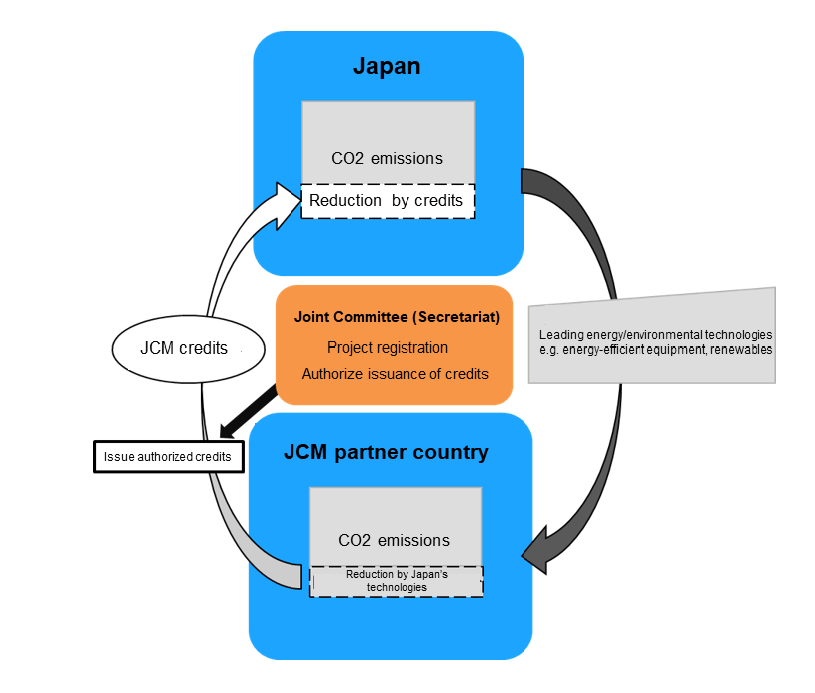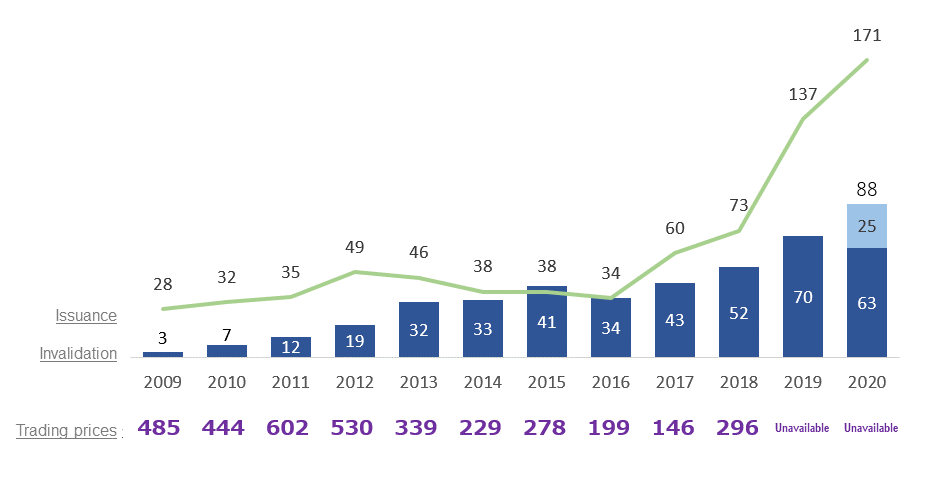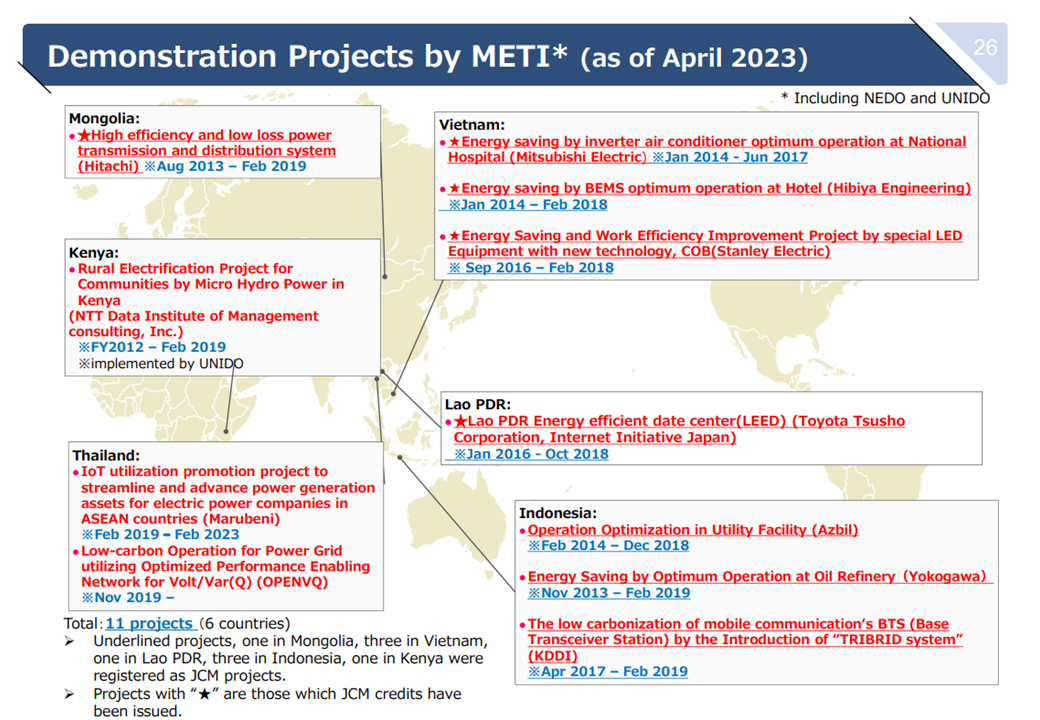The Joint Crediting Mechanism in focus as a countermeasure against global warming
(in provisional translation)
(English ver.) 2023-11-08

The Joint Crediting Mechanism (JCM) started as one of the countermeasures against global warming. It is a mechanism that disseminates leading environmental technologies across partner countries mainly in the developing world. It will not only contribute to the global efforts to reduce CO2 emissions but also help Japan achieve its climate goals. As the momentum toward decarbonization has been building in recent years, the JCM is expected to offer promising solutions. This article presents the current status and future potential of the JCM.
The JCM contributes to global efforts in reducing CO2 with Japanese technologies
The JCM is a mechanism that disseminates leading technologies for decarbonization to partner countries. It will not only contribute to global efforts in reducing CO2 emissions but also help Japan achieve its reduction targets with its contribution evaluated quantitatively. Japanese companies implement projects in cooperation with local companies in partner countries, and the greenhouse gases, such as CO2, reduced/removed in those projects are deemed to be credits, which are acquired by Japan to achieve its GHG reduction targets.
The JCM scheme

The government of Japan aims to reduce GHG emissions by 46% by FY2030 from FY2013 levels. One of the efforts toward achieving the target is to enhance the utilization of JCM. The government aims to reduce/remove 100 million tons of GHG emissions by FY2030 on a cumulative basis by utilizing the JCM. This is more than five times as much as the amount estimated as of the end of FY2020, and will require funds amounting to one trillion yen in the public and private sectors combined.
This movement takes place against the background of the increasing concern about the environment and global warming. The JCM will not only contribute to countermeasures against global warming but also can be utilized by private companies to achieve their GHG reduction targets and voluntary goals. As it also provides opportunities for acquiring overseas markets, the private sector is becoming more interested in active utilization of the JCM, not to mention the government.
JCM projects are underway in 26 partner countries
(This paragraph is updated based on the data as of April 2023.)
Japan has been holding discussions about the JCM with developing countries since 2011, and as of April 2023, has established partnership relations with 26 countries. Many projects have been implemented, and some of them were successfully completed with credits issued. One of the projects METI is conducting is related to the power system in Thailand. It is briefly explained below.
Optimized control of the power transmission system using ICT

Courtesy by EGAT
A critical challenge facing the power system in Thailand is the loss of electricity over the power grid.
The introduction of renewable energy is required in Thailand, where thermal power is currently the major source of electricity. In order to supply electricity generated by multiple power sources in a stable manner, it is essential to reinforce the power transmission system and optimize the voltage in the power grid.
NEDO and the Ministry of Energy of Thailand reached an agreement on the demonstration project for low-carbonization and sophistication of the power grid, in order to simultaneously pursue the curbing of transmission loss and ensure a stable supply of electricity. The project, named OPENVQ,* is underway jointly by Hitachi Ltd. and the Electricity Generating Authority of Thailand (EGAT).
*Optimized Performance Enabling Network for Volt/Var(Q)
The system employed by this project for demonstration collects data from the power grid control system and combines them with other information, such as power generating plans and weather forecasts, thereby predicting the status of the power grid and supply/demand balance in the future. The project aims to contribute to reducing CO2 emissions by operating the power system online in an optimized manner.
Various forms of credit trading are emerging globally
There are various types of crediting systems, many of which are led by national governments, as in the case with the JCM. However, voluntary crediting systems are emerging globally and are operated by non-governmental organizations.
Voluntary credits are utilized mainly by private companies trying to achieve their own targets for reducing CO2 emissions, and their trading volumes are increasing because companies are becoming more concerned about global warming. The trading volumes of voluntary credits are far smaller than those of government-led credits. However, it is expected that the issuance of voluntary credits will increase in the future.
Trends in trading of voluntary credits

(Source) Created by METI based on Ecosystem Marketplace, Press Search, VCS, GS, CAR, ACR, and Plan Vivo Market Registry
Expansion of the JCM into an international standard
There are a number of challenges that need to be overcome toward expanding the utilization of the JCM.
First, we must raise the degree of recognition of the JCM. Article 6 of the Paris Agreement stipulates a mechanism through which “a company in one country can reduce emissions in that country and have those reductions credited so that it can sell them to another company in another country. That second company may use them for complying with its own emission reduction obligations or to help it meet net-zero. (Taken from the UN website.) The JCM is a pioneering initiative for this. There is a possibility that the JCM can contribute to international rulemaking for the counting of reduction amounts and also to the future utilization of a market mechanism. For this purpose, we need to raise the degree of recognition of the JCM and make use of the experience and data obtained from the projects.
Second, we need to expand partner countries. We must establish relationships with countries and areas with which we can jointly implement projects for reducing GHG emissions from a long-term perspective.
Third, larger-scale projects should be promoted with diversified financial sources. With cost effectiveness taken into account, plans are being explored to promote sizable projects that bring about a greater reduction in CO2 emissions. More specifically, projects with large-scale renewables, hydrogen, and CCS (Carbon dioxide Capture and Storage) will be considered. In order to enlarge the project size, it is essential to diversify financial sources, including public funds.
Fourth, we need to establish a system in which projects are promoted with private funds. A more flexible system is required in order to meet the increasing demand for credits by private companies, while the government endeavors to achieve CO2 reduction goals. From this viewpoint, in addition to the existing government-funded projects, it is important to promote projects developed and financed mainly by the private sector. We need to ascertain challenges that lie ahead toward organizing such projects and develop necessary rules to address those challenges.
Climate change is a global challenge that cannot be overcome unless various countries work together. Crediting mechanisms, such as the JCM, are expected to encourage countries to make a concerted effort toward promoting low carbonization/decarbonization technologies with the aim of removing GHG emissions.
Division in charge
About this article
Global Environmental Affairs Office, Environmental Policy Division, Industrial Science, Technology and Environment Policy Bureau, METI
About Special Contents
Research and Public Relations Office, Commissioner’s Secretariat, ANRE
![]() The original Japanese text of this article; Click here
The original Japanese text of this article; Click here
